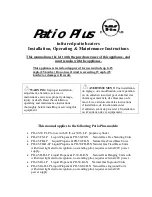
INSTALLATION
12
Note:
The storage tank should not be placed in direct contact with a concrete surface that is less than two
months old and not fully cured as this may attack the metal coating of the storage tank base. A moisture
barrier must be used between the two surfaces in this instance.
It is important to have the heater in position before installing the insulation. (
Refer to page
14)
Lifting of Storage Tank
Each storage tank is supplied with suitable lifting lugs located at the top of the cylinder. Refer to storage tank
technical data and the rating plate for tank weight. For other than 1000L tanks, the tank must be lifted from
the horizontal into its vertical orientation. Take care when removing the straps from the palletised storage
cylinder as they may be under tension. Employ safe lifting techniques when locating the tank during
installation.
Remember all local authorities have regulations about putting storage tanks into roof spaces.
Refer to the
instructions on pages
20
for storage tank installation options. Refer to the
Application Guide
for
the most appropriate configuration.
SAFE TRAY
Where damage to property can occur in the event of the storage tank leaking, the
storage tank must be installed in a safe tray or the area be suitably bunded.
Construction, installation and draining of a safe tray must comply with
AS/NZS 3500.4 and all local codes and regulatory authority requirements.
AS/NZS 3500.4 also has particular requirements when a safe tray must be installed.
SUPPLY PRESSURE
The supply pressure must not exceed that shown in the table below.
Tank Nominal Capacity
1000 – 5000 L
Relief valve setting
500kPa
Max. supply pressure
400kPa
If the storage tank is supplied with water from a tank supply the minimum pressure must be suitable for any
primary heating source attached to the storage tank. Refer to the installation instructions of the primary
heating source
Hot Water Delivery
This storage tank can deliver water at temperatures which can cause scalding.
It is necessary and we recommend that a temperature limiting device be fitted between the storage tank and
the hot water outlets in any ablution and public areas such as bathrooms, ensuites or public amenities to
reduce the risk of scalding. The installing plumber may have a legal obligation to ensure the installation of this
storage tank meets the delivery water temperature requirements of AS/NZS 3500.4 so that scalding water
temperatures are not delivered to a bathroom, ensuite, or other ablution or public area.
Refer to instructions supplied with secondary water heating plant for further information regarding the
application of temperature limiting devices.
REDUCING HEAT LOSSES
The cold water line to, primary flow and return lines and the hot water line from the storage tank must be
insulated in accordance with the requirements of AS/NZS 3500.4. The insulation must be weatherproof and
UV resistant if exposed.
Keep temperature settings down. Lower temperatures reduce heat losses and prolong cylinder life.
SADDLING PIPE WORK
Pipe work must not be saddled to the tank.
Note: If the cylinder or insulation is damaged as a result of attaching pipe clips or saddles to the
jacket, any resultant faults will not be covered by the Rheem warranty.













































